Sewing Glossary
This glossary of common sewing terms lists all common (and less common) sewing terms used in the sewing industry so pin this to your Favorites bar for easy access when working on that next sewing project!
Sewing Glossary A-Z
A
A-line
An A-line skirt is a skirt that is fitted at your hips and gradually widens towards the hem, giving the impression of the shape of a capital letter A. The term is also used to describe dresses and coats with a similar shape.

Applique
Appliqué is ornamental needlework in which pieces of fabric in different shapes and patterns are sewn or stuck onto a larger piece to form a picture or pattern. It is commonly used as decoration, especially on garments and the technique is accomplished either by hand or machine. I use to make a lot of applique projects before I bought my embroidery machine!

B
Back-Stitch
Back-stitching is sewing backward over your stitches to keep the ends of your thread from unravelling. Generally, you will sew forward a few stitches, then back-stitch a few stitches, and then continue on forward sewing but you don’t want to back-stitch back and forth too much or you’ll create a big lump of thread and will likely pucker your fabric. So, I generally sew forward 3-4 stitches, back-stitch the same amount, and then continue sewing forward.

Baste, Basting Stitches AKA “Tacking”
A basting stitch is a set of long stitches (here I mean, turn your stitch length on your machine up to the longest possible) that are usually used to hold something together temporarily.
For example, sometimes you’ll baste two pieces of fabric together to keep them in place while you sew those 2 pieces to another piece of fabric or sometimes you’ll baste an applique onto your fabric to keep it in place while you then sew the edges down permanently.
I probably baste the most often when I am creating gathers or ruffles. You can baste by hand (I tend to do this most often) or set your machine to its longest stitch and do a machine baste.


Bias
The bias of the fabric is the diagonal line between the horizontal and vertical grain lines; by diagonal, I mean a 45 degree slice between those lines.
Look at a piece of fabric flat in front of you. The selvage is laying right along the bottom; that would mean that your horizontal grain lines are also running perfectly straight across from left to right.
This would also mean that your vertical lines are running perfectly up and down, creating a nice 90 degree angle to your selvage. The BIAS LINE would run at an exact 45 degree angle from the selvage.

The easiest way to find the bias is to use your selvedge as a guide. Once you have cut your length of fabric, use a table or meter rule to help you cut a neat straight line from the one selvedge to the other.
This should be at a 90 degree angle to the edge of your fabric. Then, fold the newly cut edge over and bring it in line with the selvedge edge. THIS fold created will be the 45 degree angle you need — the Bias line. Some sewing patterns may require you to place a pattern piece “on the bias”.
This means turning your pattern piece so that the grainline arrow runs parallel with this bias line. It may seam unnatural to place a pattern piece like that but it will make for a more flattering fit once the pattern is stitched up. Only EVER place patterns on the bias if the pattern instructs you to do so.
Note, this is the same way you make “bias binding”.

Bias Binding
Bias cut strips of fabric are used to encase the edges as a trim or finish and I love bias binding because it can be used in sooo many different ways.

Bobbin
This is the piece of your sewing machine that holds the bottom thread, and is placed in the bobbin case and can come in slightly different sizes for different makes of machine. If you buy extra bobbins for your machine, always ensure they are compatible with your machine because they come in different sizes too!
Bolt
This is the unit of fabric as sold in fabric stores and I’m positive that you have seen these! They are usually on a roll or folded over a cardboard inner, and marked with useful information such as fabric content and care instructions.

Button holes and buttons
A button hole is the cut in the fabric that is closely bound with small stitching, just large enough to allow the button to pass through. Buttons are used as a fastening and can be made from all sorts of materials, including plastic, metal, glass, ceramic and can also be covered to match the fabric of the garment. I think all sewing hoarders have “that” box of old buttons tucked away on the sewing shelf!

C
Casing
This is a folded over edge of a garment, usually at the waist, to enclose a way of adjusting fit, such as with elastic or drawstrings. A casing may also be formed between a garment and its lining.

Clip corners and curves
When sewing an item together, you’ll often see the instructions say to sew “right” sides together…and then turn right side out and iron flat. However, before turning right side out, you need to minimize the bulk around curves and corners, so that after you turn it right side out, it will lay flat and have crisp edges and lines.
You will need to clip straight lines into curves that look like a valley, cut notches into curves that look like a mountain, and then cut corners straight off…..in order to help with turning fabric right side out.


Couture (also known as Haute Couture)
Okay I’m sure we have all seen those weird and wonderful fashion shows with totally un-wearable fashion being displayed on the catwalk! Couture is fashion with a high emphasis on fit, design, finish and quality. Examples of famous couture designers are: Oscar de la Renta, Versace and Jean Paul Gaultier.

D
Darn
We have used this technique for hundreds of years both by hand and machine and is done by “scribbling” the needle over a torn section of fabric or a hole to do a repair. This requires a darning foot so the feed dogs will not direct the fabric.

Darts
Dart are folds in the fabric, usually wide at one end narrowing to a point, which helps the fit of a garment over the curves and shapes of the body. The most common darts are those we see at the bust area, and hips on our skirts and trousers.

Dress Form / Duct Tape Dress Form
A dress form is a standard model of your body which can be adjusted to your required body measurements while a duct tape dress form shares your exact shape and measurements by being formed to your own body. Dress forms are used to assist in fitting and for creating garments by draping fabric directly onto the form.


E
Ease
The allowance of space in a pattern for fit, comfort and styling, over and above exact body measurements. When we take our body measurements, if we drew out a pattern to exactly match those measurements then we would end up with skin tight clothing. That’s OK if you are using knit fabrics with good stretch. But most of us want our clothes to skim the body and flatter, not show every single lump and bump! And not every item of clothing will be made from super stretchy fabrics.
So we need some ‘ease’ in our garment if it is not to be skin tight and then split when we sit down and our bottom and thighs expand. There are typically two types of ease added to a pattern – wearing ease and design ease.
Wearing ease is the amount of extra fabric you need to move comfortably in a garment.
Design ease is the amount of extra fabric the designer has built in to give the garment its shape and style. The total amount of ease is the difference between the measurement of the finished garment and the measurement for your body.

Eyelets
These are very small rings made of metal or plastic that are inserted into the fabric with a special pair of pliers to reinforce a hole. For example, on the back of wedding dresses that lace up the back, the laces go through the eyelets. Also refers to a type of fabric with holes as the design, and each hole is created and reinforced by embroidery. You can also find larger eyelets which can be used in bag making or on curtains!

Embroidery
Embroidery is my favorite and is the craft of decorating fabric or other materials using a needle to apply thread or yarn. It may also incorporate other materials such as pearls, beads, quills, and sequins. In modern days, embroidery is usually seen on caps, hats, coats, blankets, dress shirts, denim, dresses, stockings, and golf shirts and is applied with a machine. But embroidery an also include elaborate hand stitches. If you want access to hundreds of free embroidery designs, read my post List of Free Embroidery Designs.
Empire
High waisted style bodice with a loose skirt falling from under the bust. Check out my post on Hundreds of free dress patterns.

F
Facing
To finish the edge with a fitted and matching piece of fabric or binding which are typically used at necklines and armholes.

Fat Quarter
A quarter yard of fabric, cut to measure 18 x 22 inches instead of straight across the fabric at 18 x 44 inches, mostly used in quilting, small projects and is a great stash builder!

Feed Dogs
The feet that move the fabric under the presser foot of the sewing machines that control the length of the stitch and are the little ridged metal plates that stick up from under the machine sewing foot.

Finger press
Use the heat and pressure of your fingers to make a small crease in fabric rather than using an iron.

Free motion quilting
The use of a darning foot to eliminate the feed-dogs (the feet that move the fabric) so you can move the fabric freely under the needle and effectively “draw” on the fabric with the thread in whatever shape comes to mind.

G
Gathering Fabric
Gathering is a sewing technique used to shorten the length of your fabric piece so that you can then attach it to a shorter piece of fabric. To gather a length of fabric, the easiest method is to stitch two straight lines of straight stitch, on the longest length possible (like basting) without back stitching at the start and end.
Once you have sewn both rows, hold the two top or two bobbin threads in your hands (I tend to wrap them around my finger) and gently pull the other ends, ruffling up the fabric into gathers.
Once you’ve gathered your fabric to the desired measurement, make sure the gathers are even and stitch into place either by sewing a single line across the gathers, or pinning and stitching the gathers into the garment piece.

Godet
A triangular piece of fabric inserted into a skirt to widen the bottom to add movement and fullness but is also used in sleeves and bell-bottomed pants.

Grading
A process of trimming the seam allowance in order to reduce bulk in the seams.
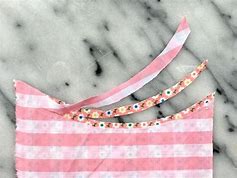
Grain
Grain refers to the orientation of the fibers that are woven together to create the fabric. Materials such as leather or fleece do not have a grain because they are not woven together. If you look really closely at the fabric below, there are little fibers that run parallel and perpendicular to the selvage.
This is the grain of the fabric. The grain that goes from one side of the fabric to the other (from selvedge to selvedge) is the crosswise grain (“weft”), and the grain that runs parallel to the selvedge is called the lengthwise grain (“warp”). Most sewing patterns will require you to place the pattern parallel to this grainline.
You can also use these grain lines in the fabric as a guide, to create straight lines that are either perpendicular or parallel to the selvage. In fact, sometimes the print on the fabric (like stripes) may be a little off, so don’t always rely on the print do give you an exact line along the grain of the fabric.
Always looks a little closer at the actual grain, to get the best results with your sewing projects!

Gusset
In a garment, a gusset is a triangular piece of fabric inserted into a seam to add roominess. In bags, a gusset is used to pinch in the corners to create a bottom and sides.

H
Hand
A term used to the feel and texture of a fabric. “This fabric has a nice hand to it.”
Hand Stitching
This is pretty self explanatory…hand stitching is done with your hand…and a needle and thread. Whenever possible, I use my sewing machine but sometimes, there are things that need to be sewn with a needle and thread.

Hem
The hem is the edge of the fabric that has been folded under and sewn to keep the raw edge hidden and from unravelling. There are different techniques to hem fabric but the most common way is to fold the edge under twice and then sew in place but sometimes all you need to do is serge or overlock the edge or hand stitch (blind hem) and that will suffice. Generally, how you are required to finish the hem depends on the fabric you’re sewing and the pattern instructions.



Hong Kong finish
This was a new one on me and I’ve been sewing for 4 decades. Nevertheless, a Hong Kong finish is an internal quality finish on a garment where the seam edges are encased in binding.

I
Inseam
This is the vertical seams on pants between the legs.

Interfacing
Interfacing is a textile attached to the “wrong” side of the fabric, to help stiffen up the fabric, when it’s otherwise too flimsy.
Invisible Hem AKA Blind hem
Sewing a hem invisibly with hand or machine stitches so as to make it nearly invisible to see from the right side sewn using a special presser foot (left).
Invisible zipper
An invisible zipper is designed to disappear into a seam when sewn in and is often used in the back of skirts and dresses where pattern matching at the seam helps make the zipper invisible. You will need a special zipper foot compatible with your machine to insert an invisible zipper correctly.

K
Knit / Jersey Fabric
When a fabric is knit, there is one continuous thread being looped together back and forth. If you look more closely, you will see that the pattern almost looks like braiding. Because of that loopy, braided technique, the fabric has a lot more give and stretch. Knit fabric is a great friend to the crafter because once cut, its edges don’t fray like woven fabrics do, since it’s only one continuous thread rather than many separate threads.

L
Lining
Used to finish the inside of a garment, to hide the seam construction, to allow for ease of putting a garment on or taking it off, and to provide a good finish. A lining is cut of the same pattern pieces as the garment and often is made of “slippery” fabrics.

M
Muslin / Toile
Muslin is the making of draft or trial garments and is the name of the fabric used in making them, however, terminology differs in US to other parts of the world where toile may also be used.
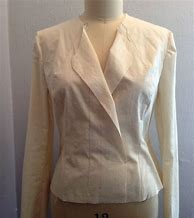
N
Nap
Some fabrics like velvet or velour have a pile, and the fibers don’t quite lay vertically, but in a particular direction. This is known as the nap and you can feel the nap if you run your hand back and forth across the fabric. When sewing, the nap should always run downwards in the project.

Neaten edges
The technique of finishing a raw edge in whatever manner you prefer, using pinking shears, zig-zag stitch, overlock stitch, or serged edge. When a pattern asks you to neaten an edge, you choose the manner in which the edge is finished.
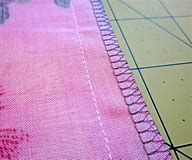
Notions
Notions are the items used in sewing other than the fabric and the pattern, for example buttons, zippers, thread, and small tools.
P
Patchwork
The art of sewing small pieces of fabric together to make a larger fabric or design, then usually quilted to be made into a quilt or bag or other project.

Pleat
A pleat (older plait) is a type of fold formed by doubling fabric back upon itself and securing it in place and is commonly used in clothing and upholstery to gather a wide piece of fabric to a narrower circumference.

Piping
A trim of a fabric-wrapped cording inserted into a seam to embellish a garment or project. The cord is wrapped in bias tape so it will curve easily around all seams. You can make your own piping or buy it by the yard. You can learn to make piping in this 3 part series: Part 1, Part 2, and Make a cushion cover with piping.

Placket
An opening in the upper part of trousers, skirts, or sleeves which allow the garments to open up to make room for the garment to be slipped on easily.

A rectangle of fabric inserted into a garment accessible from the finished outside edge of the garment to hold small items or added to the outside of a garment like the one below. Pockets can be constructed in many ways, with or without flaps or pleats, and can be various shapes.

Press
Using an iron with an up and down motion to press fabric flat rather than a back and forward ironing motion. Pressing is completed on seams during garment construction.

Presser foot
The part of the sewing machine that holds the fabric in place as it is being sewn and fed through by the feed dogs. Presser feet are usually removable and can be replaced by all types of specialty feet for sewing specific projects or stitches.

Princess Seams
Vertical seam lines which give shaping to a garment in place of darts which are often found in fitted bodices.
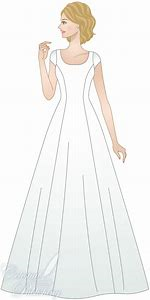
Pre-wash Fabrics

Is pre-washing your fabric necessary? Or a waste of time? Well, it depends on your fabric and what time of project you’ll be making (like if it will be washed again after it’s made, like clothing or a quilt). My quick answer is yes, pre-wash all of your fabric so that if it’s going to shrink and shift, it’s better if it happens before you start cutting your fabric. If you would like more details on pre-washing fabric, you can read Makeit-Loveit.com’s post on Should You Pre-Wash Your Fabric
Q
Quilting
A method of sewing (or tying) two layers of cloth together with an inner layer of batting between it. A “quilt” is a finished blanket made by Quilting.

R
Right vs wrong side of fabric
Most fabrics have designated sides that are meant to be “seen” and “not seen” with each side likely having a different color or texture, or both. If your fabric has a design printed onto it, you will notice that the “right” side is more vibrant. Sometimes it’s hard to tell the difference between the sides and if that’s the case, it won’t like matter which side you choose as the “right’ side.

“Right sides together”
While reading sewing patterns, you’ll often see the words, “sew the two pieces together with RIGHT sides together”. This means to place the sides of the fabric that you want to be seen (the printed/smooth/preferred sides) and then sew as instructed.
Then, when the fabric is turned right side out, the seam will be hidden.

Ruche
A ruche is a frill or pleat of fabric as decoration on a garment or soft furnishing.

S
Scrim
Scrim is a term used in batting where a thin layer of polyester is added to the cotton to be needle punched into, giving stability to your batting so it won’t break apart within your quilt. Scrim adds poly to your batting so it will no longer be 100% cotton.
Seam Allowance
A seam allowance is the distance between the edge of the fabric and the sewn line. When sewing any project, a pattern designer always includes some sort of seam allowance into the pattern pieces, so that the finished project will turn out with the intended measurements.
A very common seam allowance is 5/8 inch and this notch is usually the most visible sewing line on the sewing machine. Smaller projects usually call for smaller seam allowances.
Whatever the seam allowance, check your machine for your seam allowance guide or mark a line that you can line up the edge of your fabric with, and sew an even seam allowance along your fabric.


Selvedge / Selvage
This is the edge of the fabric which is “self-finished” and stop the fabric from fraying or unravelling. You will notice this most commonly where the fabric company prints the name of the fabric collection, designer and / the colours used in the printing process.
In most fabric stores, you will find fabric folded in half lengthwise and then wound around a bolt. And then you’ll see rows and rows of bolts of fabric. When the fabric store cuts fabric for you, they will cut you off a piece that is perpendicular to the selvage. So you will always have a selvage along both sides of your piece of fabric.

Serging or overlocking
This is a method of looped threads over the raw edge of the fabric to finish the edge to prevent fraying with this stitch being best achieved with a serger / overlocking machine.
Shirring
Several gathered seams in a row next to each other achieved by using elastic thread.

Smocking
A technique in which pleats are gathered and folded in a checkerboard formation to make a texture.


Stitch in the Ditch
This is a quilting term used to describe the method of stitching along existing seams in a patchwork piece or quilt top in order to quilt it together with the batting and backing.
It is the depression, or crevasse, that forms on the outside of the seam, when the two pieces are spread apart, as may be in the case of quilting. STITCHING is done IN that DITCH, usually on the right side, through all layers.
In fashion, it is done when a single-layer waist-band is to be secured from the outside, and the sew wishes to add minimum bulk. In this case the seam allowance is laid to one side, so that it may be contained in the over-lying waistband.

Sewing Patterns
Sewing patterns are designs used to cut fabric into shapes usually including several different sizes or styling options along with instructions on how to construct the project or garment. Patterns are also available as instant downloads from online stores, which are printed on a home printer onto A4 paper and either glued or sticky-taped together according to the pattern-maker’s instructions.
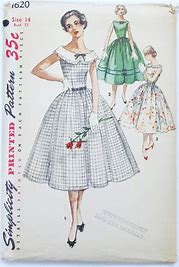
Sloper
A sloper is a basic (block) pattern from which other patterns can be designed. The custom sloper is made to your personal measurements and can be used to create very well fitting garments.

Stay stitching
Stay stitching is a line of stitching just inside the intended permanent stitching line on curved edges that stabilizes and keeps the curve from distorting. The direction of the stay stitching is shown on the pattern. If not, it generally goes from shoulder to center on necklines.

Stitches & Seams
A stitch is a loop of thread that is created by a needle pulling it through fabric and a seam is a line of stitches that can either hold two pieces of fabric together or can be used as a decorative line of stitches.
The size of each stitch within your seam can be adjusted by different knobs on your sewing machine. Seams can be created in many designs but the most common is a straight line or a zig-zag.

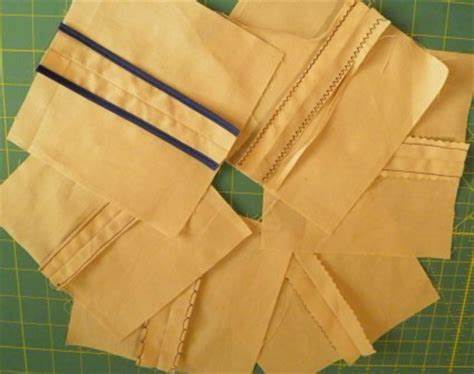
Synthetic Fabrics (Nylon, Rayon, Polyester)
Synthetic fabric is made from man-made materials with most being quite sensitive to heat and more prone to melting while ironing and steaming.
Sometimes a synthetic fabric will give you the look and flow you’re seeking, but just be aware of how it responds to sewing/ironing when selecting fabrics that are synthetic.
A good example of a synthetic fabric is satin, often used in formal wear like wedding gowns.

T
Tailors Ham
A tailors ham is a round ‘ham’ shaped firmly stuffed pillow used under a garment while pressing to help mold fabric into shape around curves for darts, princess seams etc.

Tension
Tension refers to the pressure being placed on your needle and bobbin thread by your machine. There are two types of tension on your sewing machine – the thread and bobbin tensions.
You rarely need to adjust bobbin tension and your sewing machine manual will show you the appropriate settings and offer you examples of what the threads should look like on the right and wrong sides of your stitching.

TNT
“Tried and tested” or “tried and trusted” refer to a pattern you have made up before, and which gives good results and fit, and you come back to several times to make up a wardrobe staple such as a basic skirt, dress or shirt.
Top-Stitch
Sewing a top-stitch is when you sew along the top (or the “right” side) of the fabric and generally parallels a seam or the edge of your fabric, to give the item a more tailored or professional look.
When I top-stitch, I increase my stitch length a little more when sewing top stitch because the needle hops over more fabric and doesn’t stretch out the fabric as much, but also allows for more thread to show with each stitch. (Sometimes you will hear the word edge-stitch. This is basically the same thing….but really close to the edge of the fabric, like a hem.)
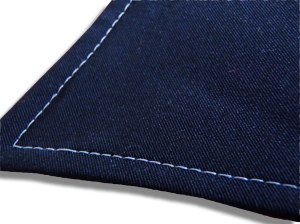
Tracing paper & tracing wheel
These are used together to transfer pattern lines and marking to fabric or to duplicate and trace patterns. The wheel resembles a tiny pizza cutter with spikes. Burda magazines are good examples which include traceable pattern pieces requiring tracing paper and a tracing wheel.

Trim or trimmings
Trims are pre-made ruffles, fringes, or other decorative accessories that can be sewn into a garment or sewing project to add visual and decorative interest.

“Turn a tube the right side out”
Turning a tube of fabric right side out is just what it sounds like, turning your fabric out after you’ve sewn it together, so that the correct side (or “right side”) is facing outward.
You may come across this when having to make spaghetti straps or belt loops. It may seem simple for some, but if you’ve never done it, this can seem frustrating. But turning something “right side out” is something you do a lot while sewing.
But those skinny tubes can be a real pain. I sometimes use a safety pin, but you can also use a loop tool.


U
Underlining
Underlining is fabric lining joined in the seams of the garment rather than hanging loosely and is used to give shape, body or support to delicate fabrics.
Under stitching
Under stitching assists a facing or lining to stay to the inside and un-seen, sewn as close to the seam line as possible holding the graded seam allowance to the facing or lining.

W
Walking Foot
A walking foot is a special presser foot which includes feed dogs to assist in moving the upper layer of fabric through the machine.
They are sometimes used in projects with multiple layers of fabric to ensure upper layers move through at the same rate as the lower layer pulled by the machine feed dogs. Typically used in quilting.
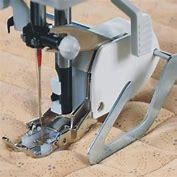
WOF
“Width of fabric” or “salvage to salvage”. You will find this abbreviation in many patterns.
Woven Fabric
When a fabric is woven, its threads are interlaced in a crisscross pattern, horizontally and vertically and because of this, woven fabric tends to hold its shape better and doesn’t stretch very well. This can be helpful when trying to keep things precise while sewing and perfectly even and straight.

However, when cut along the grain, the threads release and start to unravel, causing fraying along the edges over time. There are several ways to stop the fraying – neaten edges with a zig zag stitch or an overlock stitch (if you have an overlocker / serger).
OR another way is to cut along the bias. This stops each row of woven threads and tends to slow down the fraying process. Also, when woven fabric is pulled along the bias, it has a slight stretch to it, causing it to hang a little differently and manipulate a little better around curves (which is why bias tape is so useful).
“Wrong sides together”
Sometimes a pattern instruction will say to place the WRONG sides of the fabric together. There is a reason for this and that reason will generally make sense as you learn more about sewing. But this just means to place the unwanted sides together….and then continue on with the instructions.

Y
Yoke
The yoke is the part of a garment that fits over the shoulders or hips and to which the main part of the garment is attached. It may sound like an old-fashioned term but we have yokes in our clothing we wear everyday in modern fashion!
Z
Zipper foot
A zipper foot is a sewing machine attachment that is designed for installing zippers with the design of the foot allowing the needle to stitch close to different items such as zippers and cording. You will also need a zipper foot when making piping.

Zippers / Zips
Zippers are closures with interlocking teeth and come in several forms, colors and lengths. They usually require a special presser foot for accurate insertion. (a zipper foot as previously discussed)

Well, that is the end of the glossary folks! I hope you find it useful!
If you loved it please follow my blog and remember to share, share, share!
Happy sewing!













